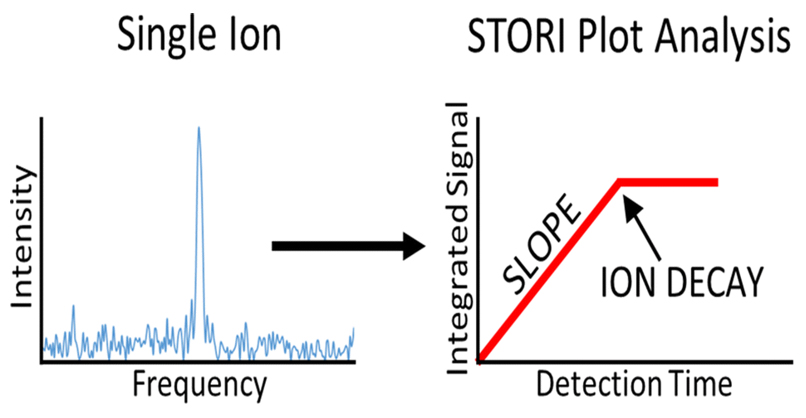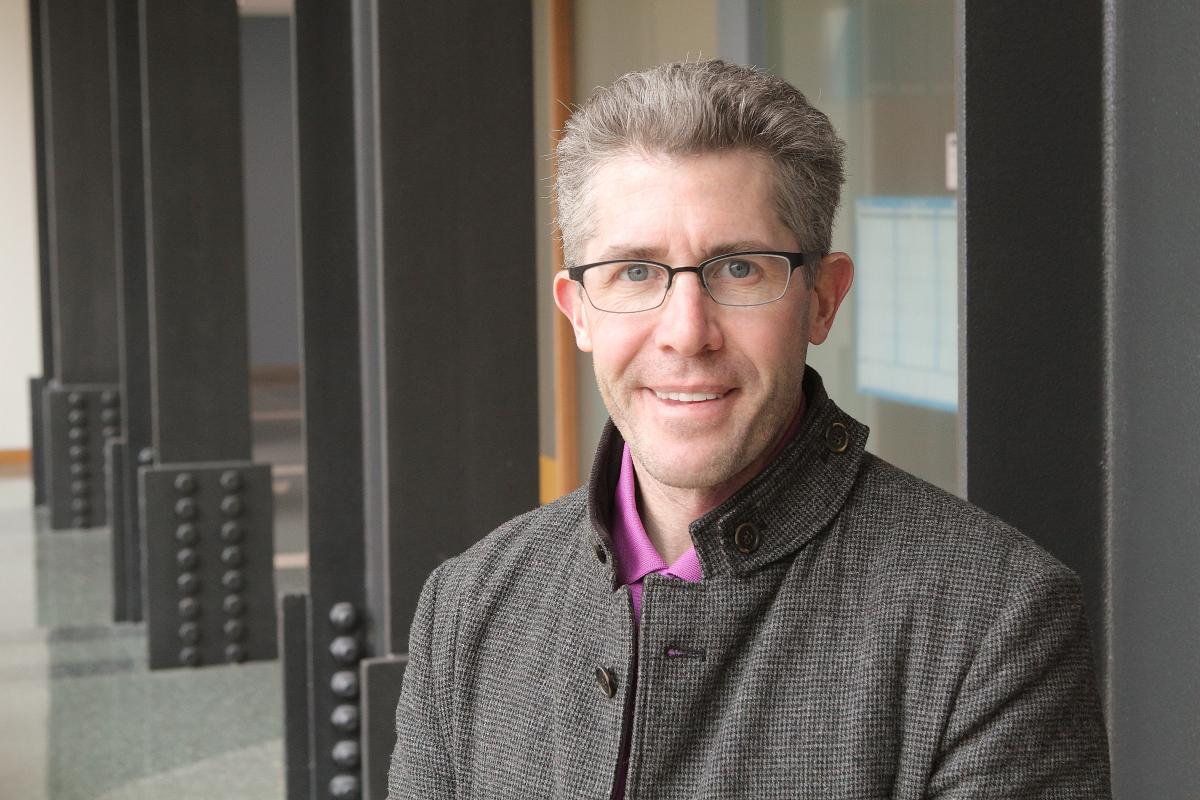October 24, 2019 | Jola Glotzer
STORI plot analysis of “tricky” ions
Or, how the Selective Temporal Overview of Resonant Ions (STORI) plots can help accurately determine the charge of troublesome ions — CBC Senior Investigator Neil Kelleher, NU, contributes
Determining a correct charge of an ion is sometimes troublesome when the ion is unstable and disintegrates during the time of the analysis or produces too low signal to unambiguously quantify it using charge detection mass spectrometry (CDMS). In a recent paper published in the Journal of American Society of Mass Spectrometry, “STORI Plots Enable Accurate Tracking of Individual Ion Signals,” the authors describe a new method that allows for more accurate ionic charge analysis, called the Selective Temporal Overview of Resonant Ions (STORI) plots.
The CBC congratulates all authors involved in the current study, including Neil Kelleher, NU, who is one of the contributors.
Kelleher is the Walter and Mary Elizabeth Glass Professor of Chemistry, Molecular Biosciences, and Medicine at NU. He is recognized as a CBC Senior Investigator due to his recruitment to NU in 2010 with help from the CBC Recruitment Resources Funds Award. Kelleher is also director of Northwestern Proteomics, an NU-based facility that has evolved from the Proteomics Center of Excellence (PCE), which was originally established with the CBC support. Kelleher’s additional CBC awards and community contributions are listed below the article. The CBC is proud to have played a role in Kelleher’s recruitment and to have helped support his research over the years.
Publication linked to *CBC funding:
Kafader JO, Beu SC, Early BP, Melani RD, Durbin KR, Zabrouskov V, Makarov AA, Maze JT, Shinholt DL, Yip PF, Kelleher NL, Compton PD, Senko MW. STORI Plots Enable Accurate Tracking of Individual Ion Signals. J Am Soc Mass Spectrom. 2019 Sep 11. [Epub ahead of print] (PubMed)
ABSTRACT:

Source: J Am Soc Mass Spectrom.
Charge detection mass spectrometry (CDMS) of low-level signals is currently limited to the analysis of individual ions that generate a persistent signal during the entire observation period. Ions that disintegrate during the observation period produce reduced frequency domain signal amplitudes, which lead to an underestimation of the ion charge state, and thus the ion mass. The charge assignment can only be corrected through an accurate determination of the time of ion disintegration. The traditional mechanisms for temporal signal analysis have severe limitations for temporal resolution, spectral resolution, and signal-to-noise ratios. Selective Temporal Overview of Resonant Ions (STORI) plots provide a new framework to accurately analyze low-level time domain signals of individual ions. STORI plots allow for complete correction of intermittent signals, the differentiation of single and multiple ions at the same frequency, and the association of signals that spontaneously change frequency.
Featured CBC Community member(s):
Neil Kelleher, NU
- CBC Exploratory Workshop (2013):
▸ The CBC Exploratory Workshop on Cellular Heterogeneity
Neil Kelleher (NU) – Workshop Organizer and Speaker - CBC Science Day (2011):
Neil Kelleher (NU) – Science Day Speaker - CBC Catalyst Award (2010):
▸ Phosphoproteomic Analysis of NADPH Oxidase Activation
PIs: Neil Kelleher (NU) and Richard Ye (UIC) - *CBC Recruitment Resources Award (2010):
▸ CBC Senior Investigator
PI: Neil Kelleher (NU) - CBC Seminar (2010):
▸ Top Down Mass Spectrometry: Has Its Decade Now Come?
Neil Kelleher (NU, UIUC then) – Seminar Speaker
ARTICLES PUBLISHED IN THE PAST ABOUT THE FEATURED CBC COMMUNITY MEMBER(S):
October 10, 2019
▸ MicroMGx, a CBC university spinoff, to collaborate with Corteva Agriscience
Chicago-based biotech company MicroMGx, co-founded by CBC Senior Investigator Neil Kelleher, NU, will share its metabologenomics expertise with Corteva Agriscience in joined efforts to develop novel microbial-based crop protection products
October 7, 2019
▸ Of cocaine and estrogen
Or, why women are more susceptible than men to develop cocaine addiction — two CBC community members Neil Kelleher and Paul Thomas, NU, help to elucidate in a recent Journal of Proteome Research publication
October 1, 2019
▸ Ordering proteoforms
In a recent issue of Nature Methods, CBC Senior Investigator Neil Kelleher, NU, proposes a five-level classification system for proteoform identifications
August 6, 2019
▸ New oncogenic driver discovered
A CBC Lever Award plus a quartet of CBC awardees: Jon Oyer, Jonathan Licht and Neil Kelleher, NU, and Alex Ruthenburg, UChicago, contribute to a recent Cancer Discovery publication
July 8, 2019
▸ Defining the NSD2 interactome
Two CBC Awardees, Jonathan Licht and Neil Kelleher, identify posttranslational modification crosstalk that may play a role in carcinogenesis
July 8, 2019
▸ New insight into liver cancer treatment
CBC Awardee Rick Silverman and a CBC Senior Investigator, Neil Kelleher, NU, collaborate on developing therapeutics for hepatocellular carcinoma (HCC)
June 17, 2019
▸ Copper centers revealed with top-down mass spectrometry
Three CBC Awards contribute to today’s publication in Nature Communications!
May 13, 2019
▸ Battling epigenetic lymphomas
CBC Senior Investigator Neil Kelleher, NU, contributes to a new publication identifying a potential novel therapeutic pathway to treat the so called EZH2 dysregulated lymphomas
May 7, 2019
▸ Proteoforms explained
A recent review in Proteomics, co-authored by a CBC Senior Investigator and proteomics expert, Neil Kelleher, NU
August 9, 2018
▸ Top-down Proteomics
CBC Senior Investigator, Neil Kelleher, NU, explains the advantages of “top-down” versus “bottom-up” proteomics in early cancer detection and progression
November 13, 2017
▸ New insights into regulation of gene expression: work from the Shilatifard lab (NU) with contributions from two CBC scientists, Neil Kelleher and Jeffrey Savas.
October 5, 2017
▸ CBC Senior Investigator, Neil Kelleher, NU, deciphers molecular assembly of a gut toxin, colibactin
February 9, 2016
▸ “Clasping” Collaboration
Three CBC Scientists Join Forces to Develop Exceptional-Quality Antibodies Displaying an Unprecedented Mode of Action

